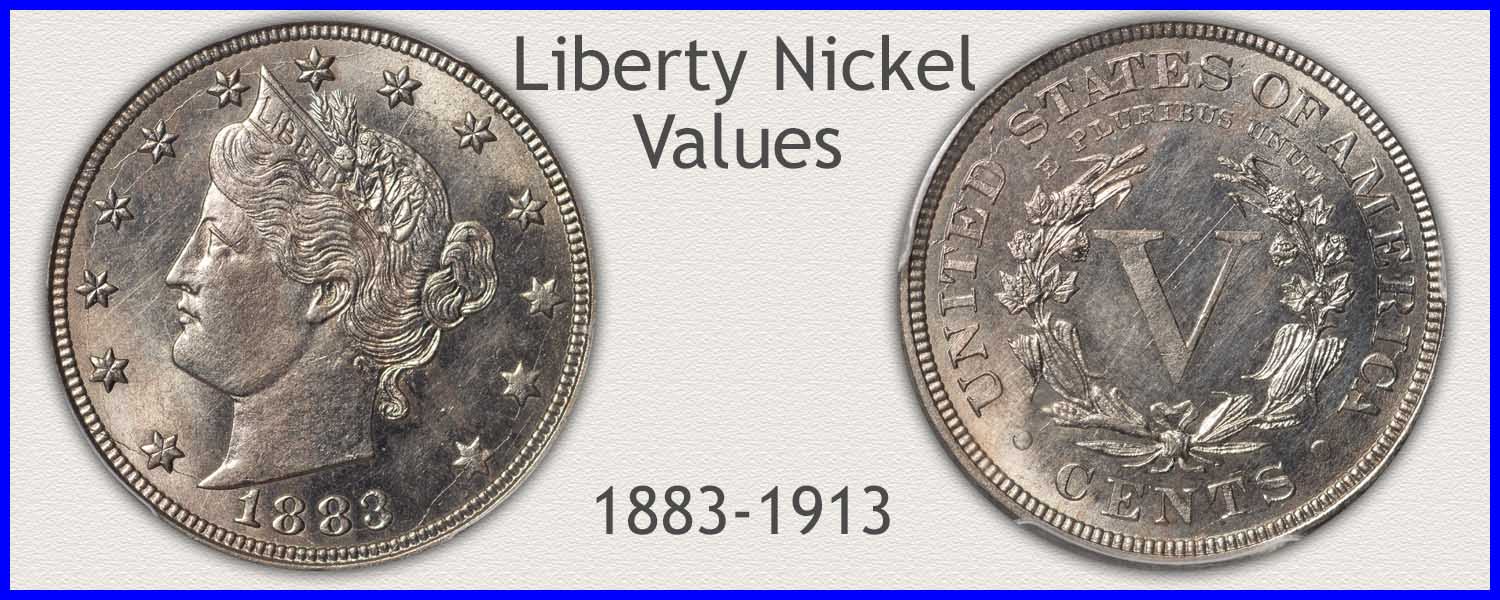Coin Values Moving with Precious Metals: Up-Dated 11/17/2025: Gold $4066 | Silver $50.70
Visual Grading Metrics
Liberty Nickel Mint State Grade
A coin's surface visibly records any disturbance of its quality. Within the coin market, Mint State preservation is a coin of highest quality. The hobby term "Mint State" defines the condition as a coin without wear or loss of its original surface. Using a series of visual grading metrics, inspects and rates key features. These rating are then scored deciding the condition of a Liberty nickel's surface quality. This decides if the surface is without wear and deserves the Mint State grade.
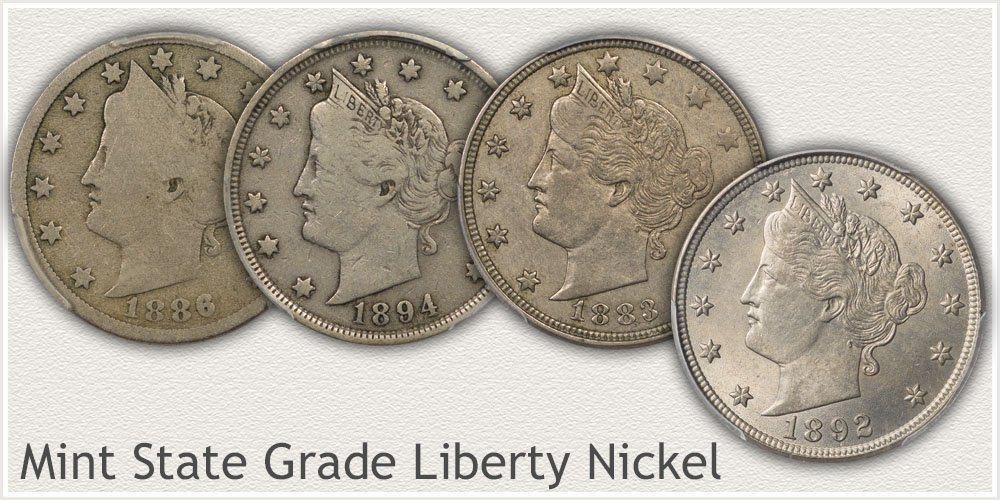 (fig. 1M) Use a Comparison to Identify a Close Match to the Mint State Grade Liberty Nickel
(fig. 1M) Use a Comparison to Identify a Close Match to the Mint State Grade Liberty Nickel
An initial examination of a coin and compared to the image (fig. 1M) begins to recognize and separate high-quality Liberty nickels. Note the presence of a fine texture and luster on the surface of the Mint State example highlighted. This brilliance reflects off the delicate surface. Inspecting high profile areas visually confirms the "no wear" condition. A strong requirement to meet Mint State grade standards.
Visual Grading Metrics Identify Liberty Nickels in Mint State Grade
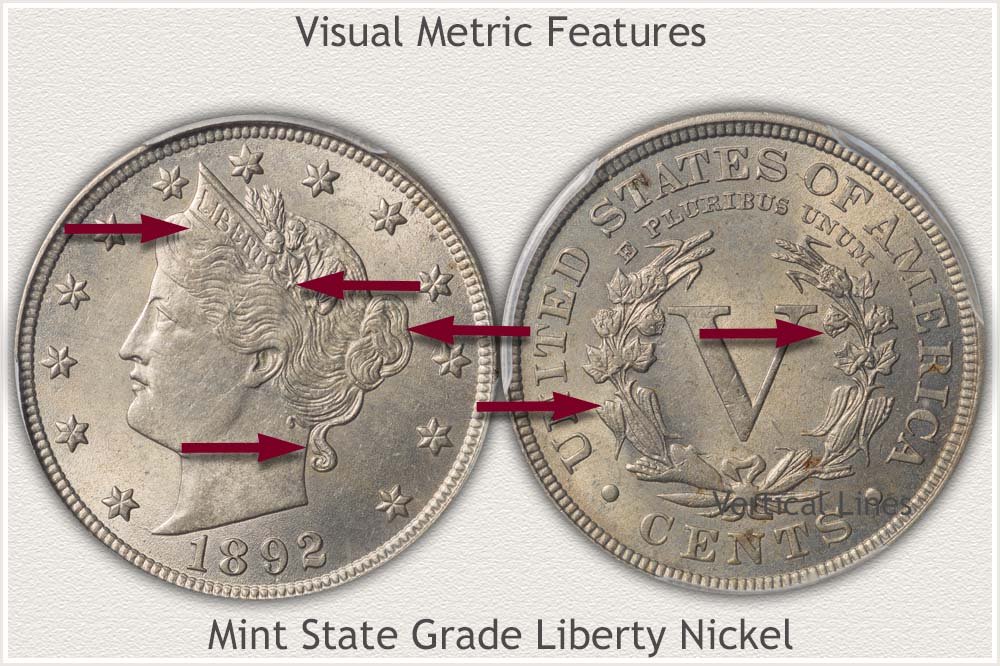 (fig. 2M) Visible Features Used to Determine a Mint State Grade Liberty Nickel
(fig. 2M) Visible Features Used to Determine a Mint State Grade Liberty Nickel
Reference the coin in illustration (fig. 2M) pointing to important areas examined during the grading inspection. Each feature highlighted remains with its original surface quality.
Subtle Differences in Surface Quality Determine the Mint State Grade
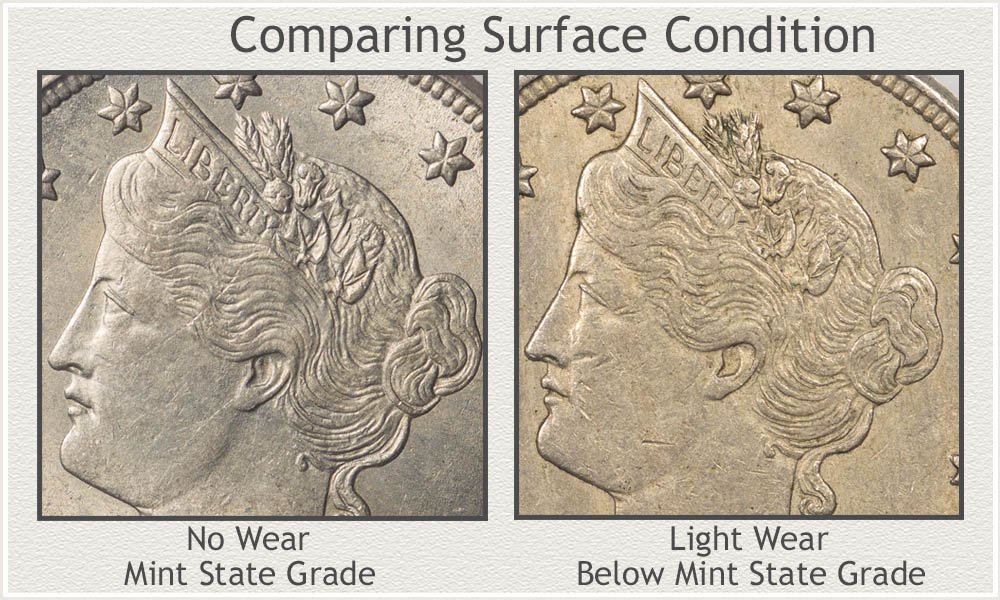 (fig. 3M) Notice the Subtle Different Qualities of a Mint State and Worn Surface on a Liberty Nickel
(fig. 3M) Notice the Subtle Different Qualities of a Mint State and Worn Surface on a Liberty Nickel
The Mint State grade requires a surface without wear to meet the standard. Slight amounts of wear result in subtle smooth areas and subtle loss of the metal texture. Comparing the illustrated coins (fig. 3M) gives an overall view of these subtle changes in surface quality.
High contour areas are the first to show any signs of circulation wear. Original surface quality, without wear, displays distinctly different than a worn surface.
Qualities of a Mint State Surface:
A fine grain texture on the metal remains. This becomes recognizable when comparing lower, protected areas to the tops of high contours. Notice on the left side coin (fig. 3M) a brilliance and shine reflects from the surface. Mint State coins have a surface covered in a fine texture imparted during the minting process. When rotating the coin under a light, a consistent shine from both high and low areas follows the rotation. This brilliance appears within Liberty's hair and along the lines of her cheek and neck.
Qualities of a Coin's Worn Surface:
Wear appears as a "smooth" texture on the metal's surface. Wear also removes the original surface texture, replacing it with a somewhat "polished" smoothness. On slightly worn coins, compare low relief areas that retain luster to see the difference with tops of high contours. When rotated and tilted under a light, a crisp luster does not follow the light across the tops of worn high points.
Worn metal on a Liberty nickel also displays a gray tone on its surface. Lost is the brilliance of a shine and replaced with a dull reflection. This change of reflective quality and slight off color between high and low areas helps detect small areas of wear.
32 Professionally Graded Mint State Liberty Nickels Rated and Scored Provide Visual Metric Data
Using the Visual Grading Metrics examination method. 32 professionally graded Mint State nickels were evaluated, rated, and then scored per metric. This provided the percentage data of those coins showing the qualities per metric. And the percentage data needed to rate a positive score. The percentage of positive scores identified the total number of qualities needed to meet the Mint State grade.
🔎Helpful Tools Used to Accurately Grade Mint State Liberty Nickels The coin hobby and market rely on two essential tools when deciding on the high-quality Mint State grade. Firstly, a magnified view of the coin's surface. Secondly, a standardized lighting of the coin.
Magnification of 5x to 7x power brings the small details inspected into a close view. At this grade level, subtle and faint differences in quality often decide on a coin's condition. A confident inspection of a coin requires magnification.
Lighting: Use a single light source of 100 watts and hold the coin 12 or so inches below. This allows luster to shine across the surface and follow the light when rotating the coin. Using this technique helps confirm luster completely covers the surface. A requirement for the Mint State grade.
Visual Grading Metric: Hair and Headband
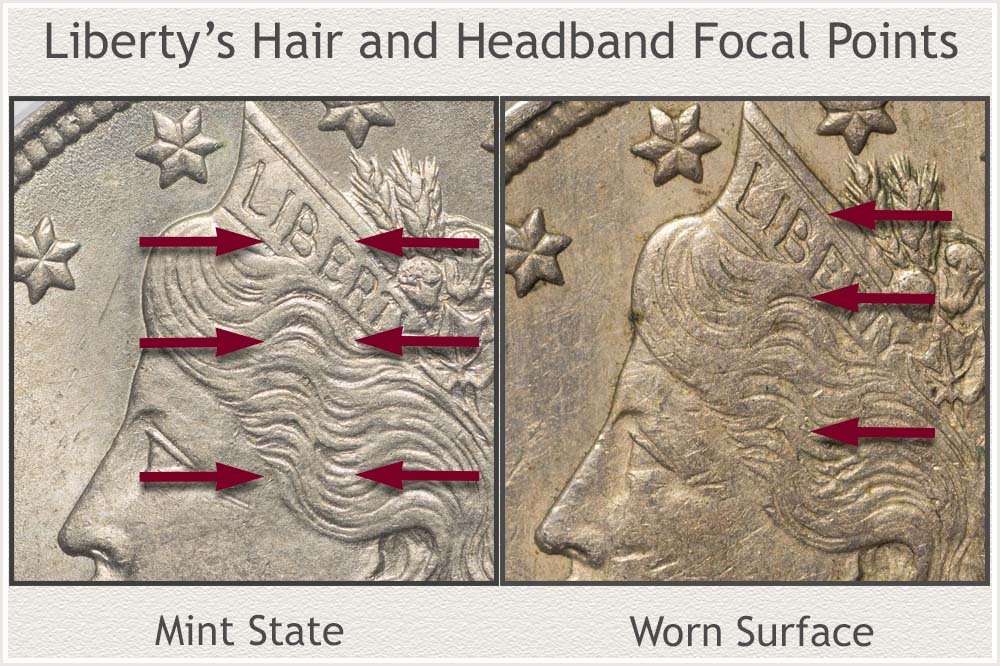 (fig. 4M) Three Areas Within Liberty's Hair and Headband are Grading Focal Points
(fig. 4M) Three Areas Within Liberty's Hair and Headband are Grading Focal Points
Liberty's portrait is a highly detailed focal point on these nickels. Her headband and the fine line detail of her hair quickly draw the eye. High in relief, the area of BE on the headband and hair strands nearby provides a useful grading metric. At the top grade level, visually fine strands of hair remain and a crisp appearance of the letters BE in the band.
Focus on three areas: the headband surrounding the letters BE, hair just below BE, and hair further below at the forehead line. Illustrated (fig. 4M) points to the exact areas.
BE of Headband: The letters within the band are recessed, leaving the band itself as high relief and prone to wear. Inspect the part of the band before the B and continue to after the E. A fine grain texture on the metal indicates an unworn surface.
Hair Just Below BE of Headband: A curl of hair overlaps the headband with strands of hair below. Inspect to confirm a contour remains on both the curl and strands of hair.
Hair Strands at the Forehead Line: Along the level of Liberty's eye, small hair waves form a delicate detail. At the Mint State grade these strands remain visible, separated, and with raised contours.
Judge the three areas closely and independently. Rate the quality of each by the following guidelines.
Visual Rating Definitions | Hair and Headband
- Mint State - No Wear: Surface remains covered in a fine texture consistent with nearby metal. Often with a nice luster.
- Visible Wear: Highest points of the headband and hair strands show a smoothness to their texture. A dull sheen or gray tone on the metal helps identify subtle wear. Inspect for any flattened surface along high contours. It is the combination of these subtle conditions on the metal indicating wear. Of note: Slight toning showing on the metal at high points does not indicate wear by itself. Toning on high areas indicates areas to inspect for wear. Rely on judging smoothness and slight flatness on the metal's surface as evidence of wear.
Rating: Hair and Headband
|
3 Areas |
2 Areas |
1 Area |
0 Areas |
Examining three distinct zones on this high point of the design begins to detect if slight amounts of wear exist. Use a rating of all 3 areas Mint State as an indication of a Positive Score for the Hair and Headband metric. Check the gray dot to record a Positive Score.
Scoring: Hair and Headband
|
|
Positive Score |
Three Areas Mint State Rates a Positive Score
Research Data Results: Hair and Headband
Study Group of 32 Mint State Grade Liberty Nickels
Each of the study nickels was inspected in the three areas: headband, hair just below, and hair above forehead. These areas produced the following percentage results.
- 97% | Of the nickels rated Mint State in all three areas.
- 3% | Showed a slight wear mark in One area.
- 0% | Displayed signs of wear in Two or More areas.
Conclusion/Key Points: It is clear this portrait area of a Liberty nickel grades strictly following the no-wear standard. Only one nickel of the 32 showed a possible slight amount of wear. Of interest, the evidence of wear was along the forehead line. This forehead line is an area known to often have a somewhat soft impression. Grading conservatively produced the result.
Register a Positive Score when Three Areas Rate Mint State.
Visual Grading Metric: Hair Above Ear
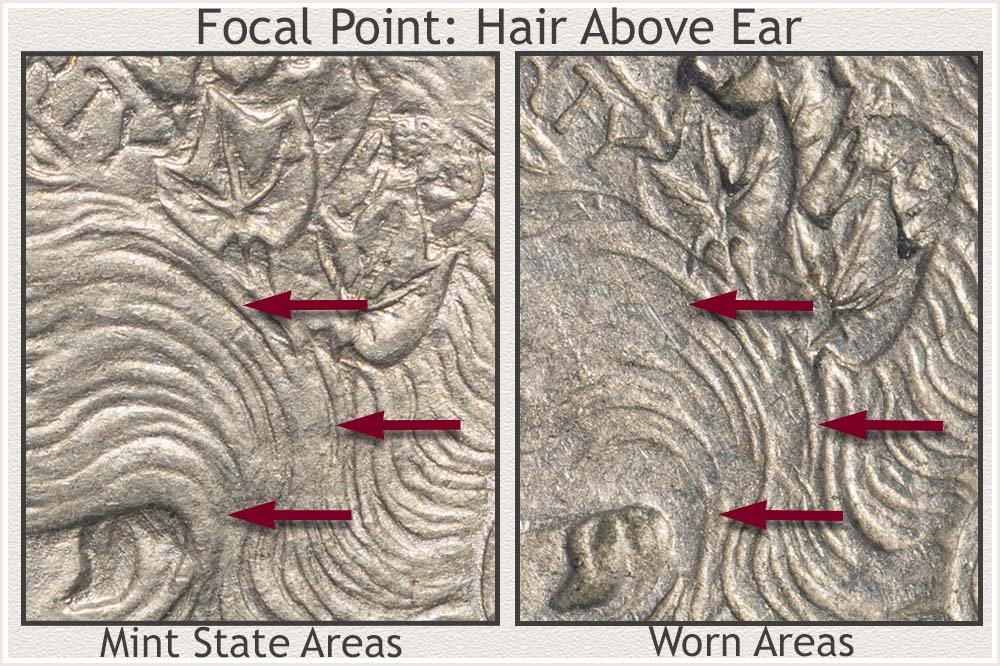 (fig. 5M) Illustration of Mint State Hair Strands Compared to Worn Condition Hair
(fig. 5M) Illustration of Mint State Hair Strands Compared to Worn Condition Hair
At this level of preservation, only a slight amount of surface disturbance determines condition. Detecting a Mint State surface focuses on small, high relief points.
Liberty's hair strands just above her ear now becomes a visual metric focal point. This area of Liberty's hair features thin, rounded top hair strands in an upward wave over her ear. Adding to the design, deep recesses separate each of the strands. By inspecting three separate zones within the area gives an overall indication if the metal is Mint State or Worn.
First area begins just above her ear. Second area is the hair strands from the TY in the headband towards the ear. The third area is hair strands in a line from the right cotton leaf towards the ear. Inspect the different conditions, textures, and contours illustrated (fig. 5M), comparing the Mint State and Worn condition hair strands.
Characteristics/Qualities/Traits/ of a Mint State Surface
In Mint State condition all strands in these areas remain with their contoured upper edges. Often found is a slight toning color change on tops of contours. This color change typically ranges to a deeper toning than lower contours. A similar metal texture overall verifies Mint State condition.
Indications of a Worn Surface
When slight amounts of wear begin to appear, once rounded upper contours of hair strands appear flattened and level. This "level top" look on strands is a noticeable trait indicating subtle wear. Coloration of a worn surface results in a "dull" tone in contrast to surrounding recessed areas.
Visual Rating Definitions | Hair Above Ear
- Mint State:A strong indication of Mint State condition is fully rounded hair strands. These show a consistent texture in all three areas. Inspect lower recesses between strands to view original metal texture as minted.
- Worn Condition: A noticeable smoothing and flattening of contours shows on the highest relief hair strands. When worn, the metal now appears with a glossy texture as compared to deeper recessed metal.
Inspect each area/zone and judge if Mint State, without evidence of wear, or determine the surface has received wear. Enter the number of areas rating Mint State.
Rating: Hair Above Ear
|
3 Areas |
2 Areas |
1 Area |
0 Areas |
Rating these subtle visual metrics requires a close view and the technique of tilting the coin under a single light. With a conservative judgement use:
2 or More Areas Mint State Rates a Positive Score
Check the dot to indicate the score.
Scoring: Hair Above Ear
|
|
Positive Score |
2 or More Areas Mint State Rates a Positive Score
Research Data Results: Hair Above Ear
Study Group of 32 Mint State Grade Liberty Nickels
These small areas on the study nickels required an intuitive comparison study when verifying visual metrics. The percentage results indicating Mint State condition of each follow.
- 81% | Visually displayed all 3 Areas as Mint State.
- 16% | Of the nickels Rated Mint State in 2 Areas.
- 3% | Displayed Mint State Condition in only 1 Area.
- 0% | None of the study nickels Rated "Worn" in all areas.
Conclusion/Key Points: Because of the area's small scale, traces of wear were subtle. Additionally, the quality and depth of strike become important when judging the presence of wear. With 16% of the nickels rated with one area showing wear, it is often due to a soft, low depth strike on the design. Interpreting and judging these areas as having wear or a soft strike becomes subjective.
Give a Positive Score to the Metric of 2 or More Areas Rated Mint State.
Visual Grading Metric: Hair Bun and Curl
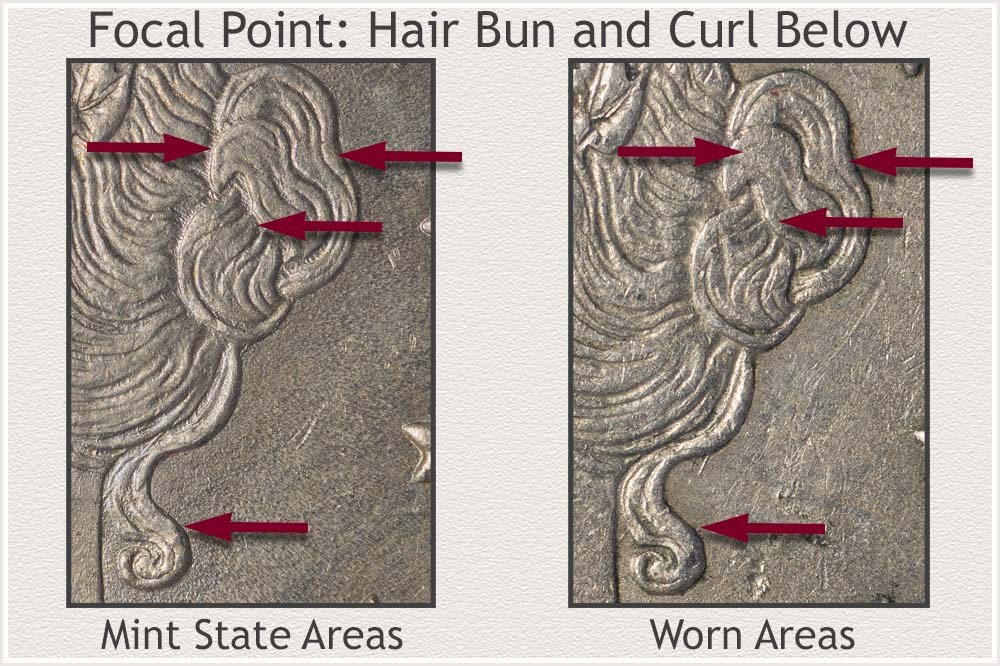 (fig. 6M) Compare the Mint State Example to a Worn Example to Judge Condition
(fig. 6M) Compare the Mint State Example to a Worn Example to Judge Condition
Located at the back of Liberty's head is a tie of hair into a Bun. This location of the design places it closer to the rim of the coin than its center. In most instances the rim helps protect elements from wear on the coin's design. However, the high relief position of the feature causes early wear to show in a subtle manner.
Combined with the Hair Bun is a small wave of hair ending in a Curl behind her neck. The delicate design with its raised and rounded hair strands, when intact, helps indicate a surface without wear.
Reference (fig. 6M) pointing to four areas to inspect. The Hair Bun with its three distinct areas and the outer edge of the Curl below. Closely comparing the Mint State example with the worn example shows the intact quality of a Mint State surface.
Three Areas of Hair Bun
A Mint State surface remains in the top area of the Bun. Nice original and even texture on the metal appears crisp.
The central area displays contoured and rounded hair strands. Focus on its upper part to detect wear.
The lower section of the Bun also has nicely detailed hair strands along its lower portion. Look at the strands near the separation line.
When judging the Hair Wave and Curl behind the neck, focus on the outer edge of the curl. The surface rates Mint State when there is no evidence of flattened metal. Comparing both the Mint State and Worn examples illustrates these small visible changes on the metal's surface.
Visual Rating Definitions | Hair Bun and Curl
- Mint State: Consistency becomes the visual indication of Mint State quality of the Hair Bun. Both upper contours and lower recessed areas of hair strands have a similar look. Textures of the high and low metal areas and their reflective shine match. Hair strands fully rounded and separated become a strong indication of an unworn surface. A close inspection of illustration (fig. 6M) shows Mint State condition of hair strands.
- Worn Condition: When worn, a difference begins to show along the upper edges of hair strands. Worn metal appears smooth and begins to lose its rounded top surface. Additionally, no longer are the recesses between strands fully defined. Strands begin to merge along their edges and have a faded, soft look. Also, the brilliance of luster fades. When tilting the coin under a light, upper surface areas now reflect a "glossy" appearance.
Using the comparison of metal surface condition, visually match the four areas to identify the Mint State or Worn metric. Judge and count each area individually to Rate and record the total results.
Rating: Hair Bun and Curl
|
4 Areas |
3 Areas |
1 or 2 Areas |
0 Areas |
Rating these four small areas has an important influence on the condition of a Liberty nickel. The difference in value between a Mint State coin and one with wear often becomes significant.
3 or 4 Areas Mint State Rates a Positive Score. Check the dot to indicate the Score.
Scoring: Hair Bun and Curl
|
|
Positive Score |
3 or 4 Areas Mint State Rates a Positive Score
Research Data Results: Hair Bun and Curl
Study Group of 32 Mint State Grade Liberty Nickels
At this stage in the evaluation, Four additional small finely detailed areas provide rating and scoring of condition. All Mint State study nickels remained with a well-preserved Hair Bun and Curl feature. The following percentage results help determine the visual metric applied to this quality condition.
- 72% | Of the nickels Rated Mint State in all four areas.
- 28% | Were solidly Mint State in 3 areas.
- 0% | Showed Wear in 2 or More Areas.
Conclusion/Key Points: In this area of the design; rating the Hair Bun and Curl, involves recognizing very small features. Slight changes in surface quality are part of the evaluation. Although 28% rated one area with wear, when grading a coin, there are subjective judgments. Importantly, all the nickels rated 3 or more areas Mint State. This becomes a strong indication as a Scoring Metric.
Record a Positive Score when 3 or More Areas Rate as Mint State.
Visual Grading Metric: Left Side Corn and Cotton Leaves
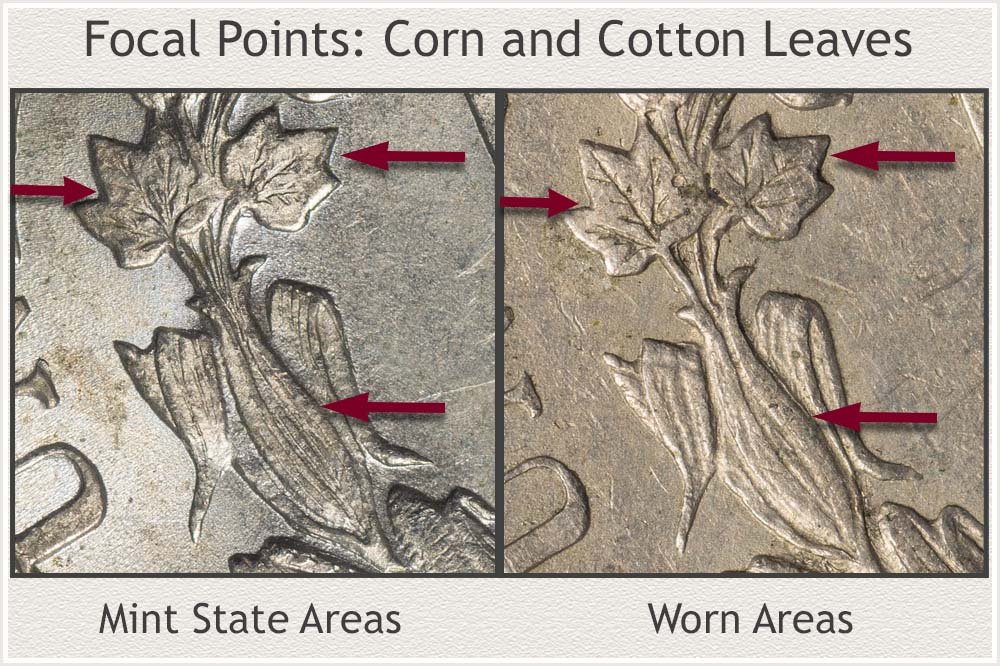 (fig. 7M) Inspection Areas on the Ear of Corn and Cotton Leaves
(fig. 7M) Inspection Areas on the Ear of Corn and Cotton Leaves
Turning to the reverse, an overall intricate design displays many areas of high and low relief. Specifically, a large wreath has many small features with fine lines and high points. A focus on defined areas provides the visual grading metrics deciding between a Mint State or Worn surface. Primary metrics are on the left side corn ear and the two cotton leaves directly above. Next, on the right side, the metrics examine the upper half of the wreath of cotton leaves, cotton bolls, and wheat grains.
Illustration (fig. 7M) gives a close-up view of the visual metric points to examine. This left side ear of corn and two cotton leaves above have both rounded contours and raised fine edges. Inspect the corn's long, raised, contoured center. On the Mint State example, roundness remains on the central areas. Additionally, both cotton leaves retain distinct higher edges around the lower centers of the leaves.
Comparing to the Worn example, note the ear of corn lacks detail in the center and has a smooth texture on the metal. When judging the two cotton leaves, also note a flattened appearance across the leaves. The central areas of the leaves have lost their "lower contour" appearance. Also, these leaves no longer give the "raised" outer edge impression.
Visual Rating Definitions | Left Side Corn and Cotton Leaves
- Mint State: The visual metric deciding Mint State condition is a combination of remaining contours and metal texture. Inspect the center of the ear of corn. A raised center with a similar texture on surrounding, lower-level metal indicates the quality grade. Next, inspect each cotton leaf independently. Similar metal texture throughout and visible high and low relief areas are typical of Mint State quality.
- Worn Condition: On smaller and delicate high points, wear quickly removes and "flattens" the visual look of the metal. On the corn feature, a smooth metal texture with a lack of contour indicates wear along the middle region. Additionally, examine the outer edges of the leaves. Wear appears on edges first and often flattens the metal towards the center of the leaf. Texture of the metal seems smooth with a different color shade than nearby metal.
Of Special Note: If the upper corn ear lacks detail, examine the corn ear below. Often this lower area suffers from a weak, incomplete strike. When both ears of corn are weak and faded and the rest of the reverse design remains sharply detailed, a weak strike has caused the issue.
Compare the three areas of the design with the examples in (fig. 7M). Rate the Center of the Corn and the Left and Right Leaves as either Mint State or Worn. Record the results of the Rating Metrics.
Rating: Corn and Cotton Leaves
|
3 Areas |
2 Areas |
1 Area |
0 Areas |
Rating these finely detailed areas closely and conservatively is a strong grading approach. Mint State grade requires high standards to achieve. When all 3 Areas Rate Mint State the surface condition indicates a Positive Score.
Scoring: Corn and Cotton Leaves
|
|
Positive Score |
All 3 Areas Mint State Rates a Positive Score
Research Data Results: Corn and Cotton Leaves
Study Group of 32 Mint State Grade Liberty Nickels
The study group of Mint State Liberty nickels rated highly and consistently, indicating a useful metric. An examine of he central area of the corn and raised features of the cotton leaves produced the following percentage results.
- 94% | Rated Mint State in all Three Metric Areas.
- 6% | Of the nickels appeared to show evidence of slight wear in One Area.
- 0% | Showed Wear in 2 or More Areas.
Conclusion/Key Points: A significant and deciding percentage, 94% of nickels rated Mint State in all three areas. This determines the strong requirement of All Three Metrics Rating Mint State becomes a Positive Score.
The 6% number represents two coins of the 32 study nickels. These showed disturbance/slight wear on one of their leaves. Although wear shows on different areas of each leaf, the high points visually record the flattening on the metal. However, depth of strike and interpretation of the cause of the disturbance remains subjective.
Visual Grading Metric: Right Side Cotton Leaves and Bolls
 (fig. 8M) Inspecting the Small Cotton Leaves and Bolls Confirms Mint State Grade
(fig. 8M) Inspecting the Small Cotton Leaves and Bolls Confirms Mint State Grade
Located on the upper Right Side of the wreath are Three Leaves and Three Cotton Bolls. Find these features just above the ear of corn. As small design elements, they are finely detailed with many areas prone to showing the first signs of wear.
When inspecting the illustration (fig. 8M), notice the cotton bolls sit well above the field. In the center of each boll, a contour rises upward. This upper area of each boll is the visual grading point to confirm a Mint State surface.
Next, the Two lower cotton leaves become the primary elements examined. Their design features outer edges contoured above a slightly lower center. Outer edges of the leaves are the focal point. In Mint State condition, the entire surface of each leaf retains its original minted surface.
This visual grading inspection includes 5 separate metrics. The Two Cotton Leaves and Three Cotton Bolls directly above.
Note: the small upper leaf does not sit as high above the surface. Because of its lower, protected profile, it generally avoids first signs of wear. It is less useful grading this leaf than the surrounding elements. At this stage of slight wear, the other leaves and bolls show signs of wear first.
Visual Rating Definitions | Right Side Cotton Leaves and Bolls
- Mint State: With the definition of No Wear on the surface, high profile, detailed elements retain an original surface texture. A fine texture remains visible across the upper surfaces. The central areas of the bolls rise upward with no flattening evident. The buds of cotton also show a granular texture without smoothness. Inspecting the two leaves, raised edges remain with a recessed center area and veins. Metal texture shows consistency across high and low points.
- Worn Condition: Once the texture of luster becomes worn, notice a soft gray color appears on the metal surface. A soft metallic shine combined with a smooth surface on high points indicates wear. Vibrant luster and intricate details now appear dull with faded, flattened areas. Cotton bolls display smooth and flattened areas across the centers and tops. Note the smoothing within the texture of the cotton buds. Inspecting the leaves, their edges quickly show signs of wear. When worn, edges flatten and merge/extend into the center of the leaf. Leaves now appear with an overall flattened appearance. Metal texture has a smooth, dull surface.
🔎Although this metric represents small features, the coin market values their condition. A magnifying glass helps determine accurately the condition of these five areas. Rate and Record the number of elements meeting the Mint State metric.
Rating: Cotton Leaves and Bolls
|
5 Areas |
4 Areas |
3 Areas |
2 or Less Areas |
The inspection of many small and subtle areas is a clear insight into the coin's surface condition. Holding to the Mint State high standard. # Areas Mint State Rates a Positive Score. Check the circle to record a positive score.
Scoring: Cotton Leaves and Bolls
|
|
Positive Score |
5 Areas Mint State Rates a Positive Score
Research Data Results: Cotton Leaves and Bolls
Study Group of 32 Mint State Grade Liberty Nickels
The number of areas inspected and their fine detail gives the Cotton leaves and Bolls a high degree of accuracy as a metric of the Mint State Condition. These delicate surface areas also proved a quick indicator of slight wear. Following are the percentage results of applying the metrics to the study nickels.
- 94% | Of the nickels rated Mint State in all Metric Areas.
- 6% | Showed slight wear on One metric Area.
- 0% | None of the study group displayed wear on 2 or more Metric Areas.
Conclusion/Key Points: Judging the condition of these five distinct and small details yielded a very strong result. Each feature, cotton leaves and bolls registers wear quickly. Only a short time in circulation causes visible wear on these high points. The 94% category of nickels with all Five Areas clearly Mint State becomes the Rating Metric.
Use a Rating of All 5 Areas Mint State to award a Positive Score to the Cotton Leaves and Bolls Visible Metric.
Final Visual Metric Scoring | Mint State Grade Liberty Nickel
With a total of 18 Metric Area Ratings grouped into 5 Major Scores, a solid percentage of the study nickels identified a Final Score. Passing these metrics with a Positive Rating gives a strong indication of their Mint State condition.
Any Liberty nickels judged as Mint State becomes highly valued to both collectors and the coin market. Liberty Nickel Values lists the complete date run of these nickels and their premium worth at the different grade levels.
A Final Score of 4 or More Positive Scores judges the condition of a Liberty Nickel as Mint State grade.
Final Scoring: Visual Metrics Mint State Grade Liberty Nickel
|
Positive Score |
Design Device |
Visual Grade Metric |
|
|
Hair and Headband |
3 Areas Mint State |
|
|
Hair Above Ear |
2 or More Areas Mint State |
|
|
Hair Bun and Curl |
3 or 4 Areas Mint State |
|
|
Corn and Cotton Leaves |
3 Areas Mint State |
|
|
Cotton Leaves and Bolls |
5 Areas Mint State |
Research Data Results: Final Scoring Mint State Grade Liberty Nickel
The Study Group of 32 Professionally Graded Mint State Liberty Nickels Produced the Following Percentage Results.
- 81% | Rated all 18 individual Metrics and all 5 Major Metrics as Positive and in Mint State Condition.
- 19% | Of the study nickels Rated at least 4 of the Major Metric Scores as Positive.
- 0% | None of the Liberty nickels Rated fewer than 4 Major Metric Scores
Conclusion/Key Points: This visual metrics study showed the strict requirement of no wear on the surface was maintained by the study nickels. With 81% of the nickels without any signs of wear it becomes a strong indication of preservation.
Among the next level of Scoring, the 19% with 4 Major Metrics Positive, also showed an extremely high level of preservation. Only 6 nickels of the group rated One Area of 18 Areas judged as having potential wear on its surface. This places these few areas within the "subjective" category. Two considerations: the evaluation process of the coins thoroughly judged many different areas on both sides. Secondly, softly struck areas on the surface often depict a deceptive/worn appearance. Importantly, one small, suspect area does not eliminate the consideration of the Mint State condition.
Definitive Results: The percentage of 0% nickels Scoring below 4 Positive Scores becomes the deciding metric.
4 or More Positive Scores Rates a Positive Final Score. A Liberty nickel scoring high using this detailed judgment is a strong candidate to grade Mint State condition.
References
U.S. Mint. Symbols on Our Coins
https://www.usmint.gov/learn/history/us-circulating-coins
U.S. Mint. Catalogue of Coins of the United States
https://nnp.wustl.edu/library/book/554591
Coin Values | CoinStudy Articles
Liberty Nickel | Visual Grading Metrics Series
Visual Grading Metrics: Liberty Nickels Extremely Fine Grade
Visual Grading Metrics: Liberty Nickels Fine Grade
Visual Grading Metrics: Liberty Nickels Good Grade
Grading Liberty Nickels | Starting Guide
Few examples of Liberty nickels remain in Mint State condition. Recognizing an accurate grade of these coins narrows how much they are worth. How to Grade Liberty Nickels reviews and starts the grading process.
How to Grade Liberty Nickels | Visual Guide
Collector's preferences change as the condition of a Liberty nickel changes. Using the visual guide begins the grading process and identifies a narrow range of condition. Close-up images point to specific grading features followed with descriptions. Also, the Video Presentation gives an overview of grades and methods.
Liberty Nickel Values
With an understanding of a grade range, place a value on these Liberty nickels. Use the step-by-step method outlined discovering their potential worth.
Liberty Nickel Values | Condition and Grade Determine Worth
Liberty nickels in top level condition are considered Scarce on the rarity scale. Reference the value chart of all Liberty nickel dates. Note the premiums for the different qualities of preservation. Follow a step-by-step method to determine how much these older nickels are worth.
★Coin Values Discovery... finds Liberty Nickel Values and...
Begin the value process by identifying the coin series. Next, each date on the coin and its condition helps decide a narrow value range. A step-by-step method works through how to determine the worth of these old coins.

